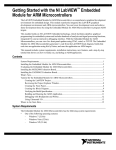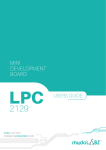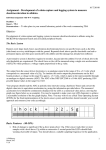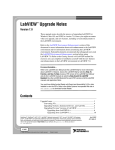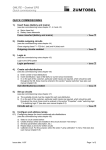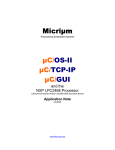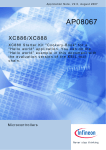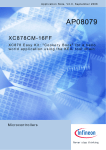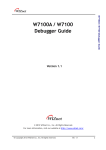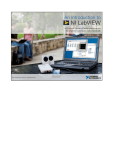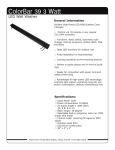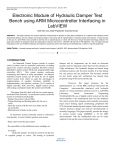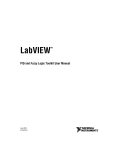Download Getting Started with the LabVIEW Embedded Module for ARM
Transcript
Getting Started with the LabVIEW™ Embedded Module for ARM Microcontrollers 1.1 For the Luminary Micro EK-LM3S8962 The LabVIEW Embedded Module for ARM Microcontrollers is a comprehensive graphical development environment for embedded design. Jointly developed by Keil–An ARM Company and National Instruments, this module seamlessly integrates the LabVIEW graphical development environment and ARM microcontrollers. You can lower development costs and achieve faster development times by using the Embedded Module for ARM Microcontrollers to program ARM targets. This module builds on NI LabVIEW Embedded technology, which facilitates dataflow graphical programming for embedded systems and includes hundreds of analysis and signal processing functions, integrated I/O, and an interactive debugging interface. With the Embedded Module for ARM Microcontrollers, you can optimize linking and view live front panel updates using JTAG, serial, or TCP/IP. The Embedded Module for ARM Microcontrollers includes the LabVIEW C Code Generator, which generates C code from the LabVIEW block diagram. This manual includes system requirements, installation instructions, new features, and a step-by-step tutorial that shows you how to build, run, and debug an ARM application. Contents System Requirements.............................................................................. 2 Installing the Embedded Module for ARM Microcontrollers ................ 3 Evaluating the Embedded Module for ARM Microcontrollers .............. 5 Installing the LM3S8962 Evaluation Board ........................................... 5 What’s New............................................................................................. 8 New Preset Build Specification Configurations .............................. 8 Improved Build Specification Conflict Notification ....................... 8 New VI-Specific Code Generation Options .................................... 8 New Project-Level Code Generation Options ................................. 9 Shared Variable Support...................................................................9 Fixed-Point Support..........................................................................10 Supported Numeric Functions...................................................10 Comparison Functions...............................................................10 Conversion Functions................................................................11 Data Manipulation Functions ....................................................11 String/Number Conversion Functions.......................................11 New Target Support .........................................................................12 New VIs and Functions ....................................................................12 New CAN VIs ...........................................................................12 New Memory Access VIs .........................................................12 New Console Output VI............................................................12 In Place Element Structure Support ..........................................13 Synchronization Functions Support ..........................................13 SPI and I2C VIs Support ...........................................................13 Expanded Support for GPIO and PWM ...........................................13 Tutorial for the Embedded Module for ARM Microcontrollers..............13 Creating the LabVIEW Project ........................................................14 Reviewing the Project Explorer Window.........................................14 Creating the Front Panel...................................................................15 Creating the Block Diagram.............................................................16 Verifying the Build Specification.....................................................17 Building and Running the ARM Application...................................18 Debugging with Breakpoints and Probes .........................................20 Using Elemental I/O .........................................................................21 Adding Elemental I/O Items to the Project ...............................22 Using Elemental I/O on the Block Diagram .............................22 Building and Running the Application with Elemental I/O......23 Where to Go from Here ...........................................................................23 System Requirements The Embedded Module for ARM Microcontrollers has the following requirements: • A computer with Windows Vista/XP/2000 • RealView Microcontroller Development Kit including Keil µVision3 • LabVIEW 8.6 with embedded support • Keil ULINK2 USB-JTAG adaptor Refer to the LabVIEW Release Notes, available by selecting Start» All Programs»National Instruments»LabVIEW»LabVIEW Manuals and opening LV_Release_Notes.pdf, for information about LabVIEW development system requirements. Embedded Module for ARM Microcontrollers 2 ni.com Installing the Embedded Module for ARM Microcontrollers The Embedded Module for ARM Microcontrollers installer includes LabVIEW 8.6 with embedded support. If you have LabVIEW 8.6 already installed, you can install LabVIEW with embedded support without first uninstalling LabVIEW 8.6. However, you must install the RealView Microcontroller Development Kit before you install the Embedded Module for ARM Microcontrollers. Complete the following steps to install the RealView Microcontroller Development Kit and the Embedded Module for ARM Microcontrollers. 1. Log in as an administrator or as a user with administrator privileges. 2. Insert the LabVIEW Embedded Module for ARM Microcontrollers installation DVD and select to install the RealView Microcontroller Development Kit. Tip If the installer does not automatically begin, double-click MDK_LV.exe on the DVD to begin installation of the RealView Microcontroller Development Kit. 3. Follow the instructions on the screen for installing the RealView Microcontroller Development Kit. 4. Activate the Keil µVision License ID Code (LIC). Complete the following steps to activate the LIC. Skip this step if you are evaluating the Embedded Module for ARM Microcontrollers. Refer to the Evaluating the Embedded Module for ARM Microcontrollers section for more information about running in evaluation mode. © National Instruments Corporation a. Launch Keil µVision by selecting Start»All Programs» Keil uVision3. b. Select File»License Management to display the License Management dialog box. c. Click the Help button to open the ARM Development Tools help file. d. Follow the instructions for obtaining a single-user license. You need an internet connection and a product serial number (PSN) to activate the license. The PSN is an alphanumeric value located on the Certificate of Ownership or license card included with purchased products. e. After you add the LIC to the License Management dialog box, click the Close button to close the dialog box. f. Exit Keil µVision before installing the Embedded Module for ARM Microcontrollers. 3 Embedded Module for ARM Microcontrollers Refer to the Keil Web site at www.keil.com/license for more information about activating Keil µVision. 5. If the installer welcome screen is still visible, select to install the Embedded Module for ARM Microcontrollers. If the installer welcome screen is not visible, double-click setup.exe on the DVD to begin installation of the Embedded Module for ARM Microcontrollers. 6. Follow the instructions on the screen for installing the Embedded Module for ARM Microcontrollers. The installation DVD installs both LabVIEW with embedded support and the Embedded Module for ARM Microcontrollers. (Luminary Micro EK-LM3S8962) You must select the Custom installation option and choose to install the Luminary Micro Driver for EK-LM3S8962. A software installation alert might appear during the driver installation. Click the Continue Anyway button to continue with the installation. 7. Follow the activation instructions that appear on the screen. Skip this step if you are evaluating the Embedded Module for ARM Microcontrollers. Refer to the Evaluating the Embedded Module for ARM Microcontrollers section for more information about running in evaluation mode. You also can use the NI License Manager, available by selecting Start»All Programs»National Instruments»NI License Manager, to activate National Instruments products. Refer to the National Instruments License Manager Help, available by selecting Help» Contents in the NI License Manager, for more information about activating NI products. 8. Restart the computer when the installer prompts you and log in as an administrator or as a user with administrator privileges. Embedded Module for ARM Microcontrollers 4 ni.com Evaluating the Embedded Module for ARM Microcontrollers You can install and evaluate the Embedded Module for ARM Microcontrollers for 60 days. When you run the Embedded Module for ARM Microcontrollers in evaluation mode, LabVIEW includes the following limitations: If you are evaluating the Embedded Module for ARM Microcontrollers with an already licensed and activated LabVIEW development system, these limitations apply only to ARM targets, VIs, and applications. Note • A 60-day time limit until the evaluation version expires—While not activated, LabVIEW prompts you to activate the product each time you launch LabVIEW. You also receive a warning when you build a VI into an application until you activate the Keil µVision License ID Code (LIC). After the evaluation period for LabVIEW expires, you are no longer able to launch LabVIEW until you purchase and activate the Embedded Module for ARM Microcontrollers. • A 128 KB size limit—Any applications you create and build with LabVIEW and Keil µVision are limited to 128 KB. • An evaluation version watermark during the 60-day time limit—All user VIs and controls contain an evaluation watermark. Installing the LM3S8962 Evaluation Board You need the following items to use the LM3S8962 evaluation board with JTAG emulation. • LM3S8962 evaluation board • An IBM-compatible PC with two unused USB ports: one to supply power to the board and the other to perform ULINK2 USB-JTAG downloading and debugging • ULINK2 USB-JTAG adaptor (included) • Two USB serial cables, each no longer than 10 feet (included) Refer to the hardware documentation for required accessories such as cables and adaptors. Caution Be careful when removing the board from the package and handling the board to avoid the discharge of static electricity, which might damage some components. © National Instruments Corporation 5 Embedded Module for ARM Microcontrollers Figure 1 shows the location of some of the parts on the LM3S8962 evaluation board. Refer to the hardware documentation for more information about the evaluation board. 1 1 2 3 2 3 4 JTAG connector USB connector Reset button 4 5 5 6 Speaker Organic LED display 6 7 7 Power LED Ethernet connector Figure 1. Locating Parts on the LM3S8962 Evaluation Board Complete the following steps to install the board. You do not have to open the computer case to install the board. 1. Verify that you have Keil µVision3 installed. µVision is a part of the RealView Microcontroller Development Kit. You can look for the Keil\uv3 directory on the hard disk or select Start»All Programs and locate the shortcut to Keil µVision3. Do not launch µVision3 from the shortcut if you are going to use LabVIEW. 2. Refer to the Installing the Embedded Module for ARM Microcontrollers section for information about installing the RealView Microcontroller Development Kit. Connect the ULINK2 USB-JTAG adaptor to a USB port on the host computer. If this is the first time connecting the ULINK2 USB-JTAG adaptor to the computer, the connection activates the Windows Found New Hardware icon in Windows. A Windows message notifies you when the new device is ready for use and the hardware installation is complete. Embedded Module for ARM Microcontrollers 6 ni.com 3. Connect the ULINK2 USB-JTAG adaptor to the JTAG connector on the board. 4. Connect the USB connector on the board to a USB port on the host computer. This USB connection provides power to the board. The power LED illuminates on the board. The board remembers the last program that ran because you must program the flash memory on the board to run an application. Therefore, the board begins running the last application as soon as the board receives power. You must download a new application to change the start-up behavior of the board. Note 5. Install the three drivers for the LM3S8962 evaluation board when the Found New Hardware Wizard prompts you. a. In the Found New Hardware Wizard welcome page, select No, not this time so that Windows does not connect to Windows Update to search for the software. b. Click the Next button. c. Select Install the software automatically (Recommended). If you did not install the Luminary Micro drivers during the software installation, you must insert the installation DVD before the wizard begins to scan the hard drive. d. Click the Next button. e. Click the Continue Anyway button when the Hardware Installation alert window opens. f. Click the Finish button when Windows finishes installing the driver. g. Repeat steps a through f to install the other two drivers. The Luminary Micro drivers create a virtual serial port over the USB connection. If you unplug the evaluation board and then plug the evaluation board into another USB port on the host, the Luminary Micro drivers create additional virtual COM ports. Note Refer to the Stellaris LM3S8962 Evaluation Board User’s Manual, available on the Luminary Micro Software and Documentation CD included with the Stellaris LM3S8962 Evaluation Kit, for more information about the LM3S8962 evaluation board. © National Instruments Corporation 7 Embedded Module for ARM Microcontrollers What’s New The Embedded Module for ARM Microcontrollers includes the following new features: New Preset Build Specification Configurations The Build Specification Properties dialog box now includes preset build configurations, such as optimizing code generation for application speed or size. When you use one of the preset configurations, LabVIEW sets the appropriate build options automatically. You can override individual options in a preset configuration. To use a preset build configuration, select a configuration from the Run-Time Options pull-down menu on the Application Information page of the Build Specification Properties dialog box. Improved Build Specification Conflict Notification The Build Specification Properties dialog box now includes a Build settings conflicts area at the bottom of each page. If you select build settings that are incompatible, such as parallel execution and expression folding, you receive notification in the Build settings conflicts area. New VI-Specific Code Generation Options You now can optimize subVI calls and inline subVIs into callers, which can eliminate overhead and increase code optimization. • Optimize subVI calls—Generates C code for subVI calls with as little default data initialization as possible. You cannot debug a VI with optimized subVI calls. • Allow inlining—Allows inlining of subVIs into callers. Inlining subVIs is most useful for small subVIs, VIs with many calls in a loop, or subVIs with only one call site. The default is True. This option only allows inlining. To actually inline a subVI, you must select True from the Inline subVI pull-down menu on the Source File Settings page in the Build Specification Properties dialog box. To set code generation options for a VI, select File»VI Properties from the front panel window or block diagram window to open the VI Properties dialog box. Select C Code Generation Options from the Category pull-down menu. You can select From project, True, or False. Select True to enable the option and False to disable it. The default is From project, so you only need to set the options in the VI Properties dialog box if you want to override the code generation settings in the project. Embedded Module for ARM Microcontrollers 8 ni.com New Project-Level Code Generation Options You now can allocate constants for arrays, clusters, strings, variants, and waveforms with build options on the Application Information page in the Build Specification Properties dialog box. Using stack variables overrides constant allocation. If you place a checkmark in the Use stack variables checkbox, Allocate constants is always First use and Deallocate constants is always Out of scope. First use and Out of scope was the default behavior in previous versions. • • Allocate constants—Specifies when LabVIEW allocates memory for constants. – First use—Allocates memory the first time you use constants on the block diagram. – Containing loop—Allocates memory outside of the loop that contains constants. – VI initialization—Allocates memory when the VI that contains the constants is called. – Application initialization—Allocates memory when the built application begins running on the target. Deallocate constants—Specifies when LabVIEW frees memory resources for constants. – Out of scope—Frees memory resources when the constants are no longer used. – VI end—Frees memory resources when a VI containing constants finishes executing. – Application end—Frees memory resources when the built application finishes executing on the target. Shared Variable Support You can use single-process and network-published shared variables to share data among VIs in the same embedded application or to read data from and write data to other network-published shared variables. Embedded targets support single-process shared variables and network-published shared variables. Embedded targets do not support hosting shared variables. Use the Embedded Variable Connection Manager, available by selecting Tools»ARM Module»Embedded Variable Connection Manager, to start a TCP/IP connection service between a host computer and embedded target for reading and writing shared variables. © National Instruments Corporation 9 Embedded Module for ARM Microcontrollers Fixed-Point Support The fixed-point data type has limited support. Note Overflow mode is supported, but overflow status is not supported. Supported Numeric Functions The following Numeric functions support the fixed-point data type: • Absolute Value • Add • Decrement • Increment • Multiply • Negate • Round To Nearest • Round Toward +Infinity • Round Toward –Infinity • Scale By Power Of 2 Function • Sign • Subtract • Square Comparison Functions The following Comparison functions support the fixed-point data type: • Equal? • Equal To 0? • Greater Or Equal? • Greater Or Equal To 0? • Greater? • Greater Than 0? • Less Or Equal? • Less Or Equal To 0? • Less? • Less Than 0? • Not Equal? • Not Equal To 0? Embedded Module for ARM Microcontrollers 10 ni.com Conversion Functions The following Conversion functions support the fixed-point data type: • Boolean Array To Number • Number To Boolean Array • To Byte Integer • To Double Precision Float • To Extended Precision Float • To Fixed-Point • To Long Integer • To Quad Integer • To Single Precision Float • To Unsigned Byte Integer • To Unsigned Long Integer • To Unsigned Quad Integer • To Unsigned Word Integer • To Word Integer Data Manipulation Functions The following Data Manipulation functions support the fixed-point data type: • Flatten To String • Logical Shift • Rotate Left With Carry • Rotate Right With Carry • Type Cast • Unflatten From String String/Number Conversion Functions The following String/Number Conversion functions support the fixed-point data type: • Decimal String To Number • Fract/Exp String To Number • Hexadecimal String To Number • Number To Decimal String • Number To Engineering String • Number To Exponential String • Number To Fractional String © National Instruments Corporation 11 Embedded Module for ARM Microcontrollers • Number To Hexadecimal String • Number To Octal String • Octal String To Number New Target Support In addition to the Keil MCB2300 and the Luminary Micro EK-LM3S8962 boards, the Embedded Module for ARM Microprocessors now also supports the Keil MCB2400 board, which contains an NXP LPC2468 microcontroller. Refer to the Keil Web site at www.keil.com for more information about or to purchase the MCB2400 board. New VIs and Functions New CAN VIs The Embedded Module for ARM Microcontrollers now includes a CAN palette, which includes the following VIs: • ARM CAN Open • ARM CAN Start • ARM CAN Set Receive ID • ARM CAN Read • ARM CAN Write Use these VIs to communicate with a controller area network (CAN). New Memory Access VIs The Embedded Module for ARM Microcontrollers now includes a Memory Access palette, which includes the following VIs: • CCG Mem Peek 8 • CCG Mem Peek 16 • CCG Mem Peek 32 • CCG Mem Poke 8 • CCG Mem Poke 16 • CCG Mem Poke 32 Use these VIs to read and write values to specific memory addresses. New Console Output VI The Embedded Module for ARM Microcontrollers now includes a CCG Console Output VI for printf functionality. Use this VI to print text to the standard output stream, stdout, of the operating system on the target. The ARM Console Output VI in version 1.0 has been deprecated. Embedded Module for ARM Microcontrollers 12 ni.com In Place Element Structure Support The Embedded Module for ARM Microcontrollers now supports the In Place Element structure, which controls how the LabVIEW compiler performs certain operations and, in some cases, increases memory and VI efficiency. Synchronization Functions Support The Embedded Module for ARM Microcontrollers supports the following new Synchronization functions: • Lossy Enqueue Element • Wait on Notification from Multiple with Notifier History • Wait on Notification with Notifier History SPI and I2C VIs Support The EK-LM3S8962 target now supports the SPI and I2C VIs on the ARM palette. Expanded Support for GPIO and PWM The EK-LM3S8962 target now contains expanded support for PWM and GPIO. You now can use Elemental I/O Property Nodes to configure GPIO inputs and outputs. You can read and write GPIO values to all pins of a port simultaneously in addition to reading and writing values to individual pins. You can use the Manage Interrupts page of the Build Specification Properties dialog box to process GPIO-triggered interrupts. You also can use Elemental I/O Property Nodes to configure PWM outputs. This version of the Embedded Module for ARM Microcontrollers includes expanded PWM support for advanced PWM features such as alignment, synchronization, deadband control, output, and fault control. Tutorial for the Embedded Module for ARM Microcontrollers Use this tutorial to learn how to build, run, and debug an ARM application. In this tutorial, you create a VI that you build into an application and run on the ARM target. You use the front panel on the host computer as a debugging interface between the host computer and the target. An LED indicator on the front panel lights when an input exceeds a threshold you define. Then, you add Elemental I/O to the VI that lights an LED on the target when the input exceeds the threshold. © National Instruments Corporation 13 Embedded Module for ARM Microcontrollers Creating the LabVIEW Project Use LabVIEW projects (.lvproj) to group together LabVIEW files and non-LabVIEW files, create build specifications for building a VI into an ARM application, and run the application on the target. You must use a project to build an ARM VI into an ARM application. Complete the following steps to create a project with an ARM target and a blank VI. 1. Launch LabVIEW. In the Getting Started window, select ARM Project from the Targets pull-down menu. Click the Go button to launch the ARM Project Wizard. 2. Select New ARM project, blank VI in the Project type pull-down menu to create the LabVIEW project with a blank VI. The New ARM project, existing VI imports an existing VI rather than creating a new, blank VI. Tip 3. Click the Next button to display the Select ARM target type page. 4. Select the target from the Target type pull-down menu. 5. Click the Next button to display the System preview page. 6. Verify the Create a build specification checkbox contains a checkmark. Build specifications contain the build settings and code generation options to use when you build a VI into an application. 7. Click the Finish button. Because the Create a build specification checkbox contains a checkmark, the ARM Project Wizard creates a build specification with default settings. LabVIEW prompts you to save the project and VI before the ARM Project Wizard can create the build specification. The project now appears in the Project Explorer window. Reviewing the Project Explorer Window The Project Explorer window includes two pages, the Items page and the Files page. The Items page displays the project items as they exist in the project tree. The Files page displays the project items that have a corresponding file on disk. Project operations on the Files page both reflect and update the contents on disk. You can switch from one page to the other by clicking the Items and Files tabs or by right-clicking a folder or item under a target and selecting Show in Items View or Show in Files View from the shortcut menu. Expand the ARM target in the Project Explorer window. The VI you created with the ARM Project Wizard appears under the ARM target. Embedded Module for ARM Microcontrollers 14 ni.com LabVIEW automatically adds Dependencies and Build Specifications under the target. SubVIs appear under Dependencies when you add a VI that contains subVIs to a project. Build specifications you create appear under Build Specifications. To see the build specification you created with the ARM Project Wizard, expand the Build Specifications item under the ARM target in the Project Explorer window. Application is the default build specification name. You can rename the build specification by right-clicking Application and selecting Rename from the shortcut menu or by double-clicking the build specification, which opens the Build Specification Properties dialog box, and entering a new name in the Build specification name text box. Refer to the Verifying the Build Specification section for more information about the Build Specification Properties dialog box. Creating the Front Panel The front panel window usually contains the user interface for a VI. ARM applications do not include a user interface, but you can use the front panel window as a debugging interface. In this tutorial, you create a VI with an LED indicator that lights on the front panel if the input exceeds a threshold value you define. Complete the following steps to create the front panel debugging interface. 1. Add the following controls to the front panel window: • Two numeric controls located on the Numeric palette. • One numeric indicator located on the Numeric palette. • One round LED located on the Boolean palette. Tip If you cannot find the object you want, click the Search button on the Controls palette for front panel objects or the Functions palette for block diagram objects. Type the name of the object for which you want to search. LabVIEW searches as you type and displays any matches in the search results text box. You also can press the <Ctrl-Space> keys or select View»Quick Drop to display the Quick Drop dialog box. Type the name of the object you want to add to the front panel or block diagram windows. 2. Tip Rename the controls as shown in Figure 2. • Rename one of the numeric controls to input. • Rename the other numeric control to threshold. • Rename the numeric indicator to output. • Rename the round LED to threshold exceeded?. Double-click to select a single word in a label. Triple-click to select the entire label. © National Instruments Corporation 15 Embedded Module for ARM Microcontrollers Figure 2. Changing the Labels Creating the Block Diagram The block diagram is the source code for a VI and contains a pictorial description or representation of an application. Wires carry data between the objects, or nodes, on the block diagram. The controls and indicators you added in the Creating the Front Panel section appear as terminals on the block diagram. Complete the following steps to create the block diagram as shown in Figure 3. This block diagram multiplies an input value by 2 and then lights an LED if the product is greater than the threshold value you specify. 1. Tip You also can switch to the block diagram by pressing the <Ctrl-E> keys. 2. Tip Switch to the block diagram by clicking the block diagram if it is visible or selecting Window»Show Block Diagram. Select Help»Show Context Help to display the Context Help window. The Context Help window displays basic information about LabVIEW objects when you move the cursor over each object. You also can press the <Ctrl-H> keys to open and close the Context Help window. 3. Place a While Loop, located on the Structures palette, around the controls and indicator on the block diagram. While Loops repeat the inner subdiagram until the conditional terminal, which is an input terminal, receives a particular Boolean value. Right-click the conditional terminal, shown at left, in the lower right corner of the While Loop and select Create Constant from the shortcut menu. The default Boolean constant in the While Loop is FALSE. 4. Place a Multiply function, located on the Numeric palette, on the block diagram inside the While Loop. 5. Wire the input control to the x input of the Multiply function. 6. Right-click the y input of the Multiply function and select Create» Constant from the shortcut menu. Enter 2 to multiply the value of the input control by two. Embedded Module for ARM Microcontrollers 16 ni.com 7. Place a Greater? function, located on the Comparison palette, on the block diagram. 8. Wire the x*y output of the Multiply function to the x input of the Greater? function. 9. Wire the threshold control to the y input of the Greater? function. 10. Wire the x > y? output of the Greater? function to the threshold exceeded indicator. 11. Wire the output indicator to the wire connecting the Multiply function and the Greater? function. 12. Place a Wait Until Next ms Multiple function, located on the Time, Dialog & Error palette, inside the While Loop. 13. Right-click the millisecond multiple input of the Wait Until Next ms Multiple function and select Create»Constant from the shortcut menu. Enter 100 to wait 100 milliseconds between loop iterations. 14. Save the VI. The block diagram should look similar to Figure 3. Figure 3. Creating the Block Diagram Verifying the Build Specification Use build specifications to specify how the LabVIEW C Code Generator generates C code and how to build the ARM VI into an application. You can have multiple build specifications for the same target. For example, you might want one build specification that generates debugging information and another build specification that does not generate this extra information. By default, ARM build specifications enable debugging. © National Instruments Corporation 17 Embedded Module for ARM Microcontrollers Complete the following steps to verify the settings in the build specification you created with the ARM Project Wizard. 1. Right-click the build specification in the Project Explorer window and select Properties from the shortcut menu to display the Build Specification Properties dialog box. Tip You also can double-click the build specification to open the Build Specification Properties dialog box. 2. Verify that the Enable debugging checkbox contains a checkmark and the current debugging mode is JTAG. The current debugging mode is shown under the Enable debugging checkbox. You select the debugging mode on the Advanced Debugging Options page. Tip 3. Verify the execution location is Run on target using ULINK2 to run the application on the evaluation board. 4. Select the Source Files category and verify that the VI is in the Top-level VI text box. When you use the ARM Project Wizard to create a project, LabVIEW automatically uses the VI the wizard creates as the top-level VI. When you create a project without using the wizard, you must manually select the top-level VI by clicking the blue right arrow button, shown at left, to move a VI from the source files list to the Top-level VI text box. If the ARM project contains other files, such as .c and .lib files, add these files to the Additional files list. 5. Click the OK button to close the dialog box. 6. Select File»Save All in the Project Explorer window or VI. Building and Running the ARM Application After you develop the ARM VI on the host computer, you build the VI into an application that runs on an ARM target. When you build an ARM application, the LabVIEW C Code Generator generates C code from the LabVIEW block diagram using the settings you configure in the Build Specification Properties dialog box. You must activate the Keil µVision License ID Code (LIC) before you can build an ARM application with LabVIEW. If the LIC is not activated, you receive a warning when you try to build the application. Refer to the Activating the Keil µVision License ID Code Readme, available by selecting Start»All Programs»National Instruments»LabVIEW» Readme and opening readme_ARM_uVision_Licensing.html, for information about activating the LIC. Refer to the Evaluating the Embedded Module for ARM Microcontrollers section for more information about evaluation mode. Note Embedded Module for ARM Microcontrollers 18 ni.com Complete the following steps to build, download, and run an ARM application. 1. Click the Run button, shown at left, in the VI or right-click the build specification in the Project Explorer window and select Run from the shortcut menu to build, download, and run the application on the ARM target using the settings in the Build Specification dialog box. LabVIEW displays the status of the building process, which includes compiling and linking. In addition, the Processor Status window assists in monitoring the download, connection, and execution progress of the application. Because the build specification for this application enables debugging, the application runs on the target with front panel updates on the host computer. Note Click the OK button if a dialog box appears notifying you about an updated µVision template. 2. Enter a value in the threshold numeric control on the host computer. 3. Enter different values in the input numeric control. In Figure 4, the output value on the left does not exceed the threshold value. If you change the input value so that the output value is greater than the threshold value, the threshold exceeded? LED lights. Figure 4. LED Lights when Output Exceeds Threshold Tip LabVIEW uses default values for controls and indicators when building an ARM VI into an ARM application. To change the initial values, enter the new values in the front panel controls and then select Edit»Make Current Values Default to change the initial values. You must rebuild the ARM application if you change the initial values for any of the controls. 4. © National Instruments Corporation Click the Abort Execution button, shown at left, to stop the ARM application. 19 Embedded Module for ARM Microcontrollers Debugging with Breakpoints and Probes Complete the following steps to debug the ARM tutorial application with breakpoints and probes. 1. Switch to the block diagram if it is not visible. 2. Right-click the Multiply function and select Breakpoint»Set Breakpoint from the shortcut menu. The breakpoint is highlighted with a red border around the function. This breakpoint specifies to pause execution just before the function executes. 3. Click the Run button or right-click the build specification in the Project Explorer window and select Debug or Run from the shortcut menu. Save the VI if prompted. LabVIEW also prompts you if you need to rebuild or redownload the ARM application to the ARM target. The ARM tutorial application begins running on the ARM target. When the application reaches the breakpoint during execution, the ARM target halts all operation, the application pauses, and the Pause button on the host computer, shown at left, appears red and changes to a Continue button. 4. Add probes on the wires coming into the Multiply function to see the values. a. Click the wire coming into the x input. b. Click the wire coming into the y input. As shown in Figure 5, a floating Probe window appears after you create each probe. LabVIEW numbers the Probe windows automatically and displays the same number in a glyph on the wire you click. Embedded Module for ARM Microcontrollers 20 ni.com Figure 5. Creating Probes 5. Enter a different value in the input numeric control and click the Continue button, shown at left, to see the value in the first Probe window change as the ARM application executes additional iterations of the While Loop. Repeat entering a different value in the input numeric control and clicking the Continue button a few times. 6. Click the Step Over button, shown at left, to execute the Multiply function and pause at the Greater? function, which blinks when it is ready to execute. 7. Continue clicking the Step Over button to step through the rest of the block diagram. 8. Click the Abort Execution button to stop the application. 9. Right-click the Multiply function and select Breakpoint»Clear Breakpoint from the shortcut menu to remove the breakpoint. Using Elemental I/O Elemental I/O resources are fixed elements of ARM targets that you use to transfer data among the different parts of the target. Each Elemental I/O resource has a specific type, such as digital, analog, or PWM. For example, you can use digital Elemental I/O resources to manipulate an LED on the ARM target. Refer to the LabVIEW Help for more information about using Elemental I/O with ARM targets. The following sections describe how to use Elemental I/O to light an LED on the ARM target when the threshold is exceeded. © National Instruments Corporation 21 Embedded Module for ARM Microcontrollers Adding Elemental I/O Items to the Project You must add Elemental I/O items to the project before you can use Elemental I/O in an ARM VI. Complete the following steps to add Elemental I/O items to the project. 1. Right-click EK-LM3S8962 in the Project Explorer window and select New»Elemental I/O from the shortcut menu to display the New Elemental I/O dialog box. 2. Expand Digital Output in the Available Resources list. 3. Select LED0. 4. Click the Add button to add LED0 to the New Elemental I/O list. 5. Click the OK button to add the Elemental I/O item to the LabVIEW project. Many pins on ARM targets can have multiple configurations. For example, LED0 and PWM1 both use the same pin on the EK-LM3S8962 board. Therefore, you cannot use both LED0 and PWM1 in the same application. If you add LED0 and PWM1 to the project at the same time, LabVIEW indicates a conflict on the PWM2 item in the Project Explorer window. After you add Elemental I/O items to the project, LabVIEW filters the available resources in the New Elemental I/O dialog box to remove resources with pin conflicts. If you right-click the target and select New»Elemental I/O from the shortcut menu again, notice that PWM1 is no longer available in the Available Resources list because you already added LED0 to the project. Using Elemental I/O on the Block Diagram You can use Elemental I/O on the block diagram after you add Elemental I/O items to the project. Complete the following steps to use Elemental I/O on the block diagram. 1. Drag LED0 from the Project Explorer window to the block diagram above the threshold exceeded? indicator and inside of the While Loop. 2. Wire the x > y? output of the Greater? function to the LED0 item in the Elemental I/O Node. Refer to the Using Elemental I/O Nodes topic in the LabVIEW Help for more information about using Elemental I/O Nodes. Embedded Module for ARM Microcontrollers 22 ni.com Building and Running the Application with Elemental I/O Before you run the application, verify that LabVIEW is downloading to the target and not to the simulator. In the Build Specification Properties dialog box, verify Run on target using ULINK2 is selected. Note Complete the following steps to run the ARM application with Elemental I/O. 1. Click the Run button. Save the VI if prompted. 2. Click the Yes button when LabVIEW prompts you to rebuild the embedded application. 3. Enter different values in the input numeric control until the threshold exceeded? indicator lights on the front panel. When the threshold exceeded? indicator lights on the host computer, LED0 on the ARM target also lights. 4. Click the Abort Execution button to stop the ARM application. Where to Go from Here National Instruments provides many resources to help you succeed with your NI products. Use the following related documentation as you continue exploring LabVIEW and the Embedded Module for ARM Microcontrollers. • LabVIEW Help, available by selecting Help»Search the LabVIEW Help in LabVIEW, provides information about LabVIEW programming, step-by-step instructions for using LabVIEW, and reference information about LabVIEW VIs, functions, palettes, menus, and tools. Refer to the Embedded Module for ARM Microcontrollers book on the Contents tab of the LabVIEW Help for information specific to the Embedded Module for ARM Microcontrollers and the applications you create. The LabVIEW Help uses (ARM) in the index to indicate topics specific to the Embedded Module for ARM Microprocessors. The LabVIEW Help uses (Embedded Targets) in the index to indicate topics that are relevant to all embedded targets. • Context help provides brief descriptions of VIs, functions, and dialog boxes. Context help for most VIs and functions include a link to the complete reference for a VI or function. Select Help»Show Context Help to display the Context Help window. • Examples, available from the NI Example Finder and in the labview\ examples\lvemb\ARM directory, can help you get started creating applications. © National Instruments Corporation 23 Embedded Module for ARM Microcontrollers • The readme file, available by selecting Start»All Programs»National Instruments»LabVIEW»Readme and opening readme_ARM.html, contains known issues and last-minute information. • Getting Started with LabVIEW manual, available by selecting Start»All Programs»National Instruments»LabVIEW» LabVIEW Manuals and opening LV_Getting_Started.pdf, provides information about the LabVIEW graphical programming environment and the basic LabVIEW features you use to build data acquisition and instrument control applications. • Stellaris LM3S8962 Evaluation Board User’s Manual, available on the Luminary Micro Software and Documentation CD included with the Stellaris LM3S8962 Evaluation Kit, provides detailed information about the various parts on the LM3S8962 evaluation board. • If you are considering moving to custom hardware, the LM3S8962 Microcontroller Data Sheet, available on the Luminary Micro Software and Documentation CD included with the Stellaris LM3S8962 Evaluation Kit, provides reference information for the LM3S8962 microcontroller. National Instruments, NI, ni.com, and LabVIEW are trademarks of National Instruments Corporation. Refer to the Terms of Use section on ni.com/legal for more information about National Instruments trademarks. Other product and company names mentioned herein are trademarks or trade names of their respective companies. For patents covering National Instruments products/technology, refer to the appropriate location: Help»Patents in your software, the patents.txt file on your media, or the National Instruments Patent Notice at ni.com/patents. © 2008 National Instruments Corporation. All rights reserved. 374931B-01 Sep08
























